Psychology Report: Substance Abuse, Cannabis Disorder and Treatment
VerifiedAdded on 2022/08/18
|11
|2452
|351
Report
AI Summary
This report delves into the multifaceted issue of cannabis use disorder, exploring its etiology, development, and the diagnostic criteria outlined in the DSM-5. It examines the increasing societal acceptance of marijuana and its implications, differentiating between use, misuse, and abuse. The report analyzes the various factors contributing to substance abuse, including social and psychological influences. It also details the problematic use of cannabis, including its impact on memory, perception, and cognitive development, along with the withdrawal symptoms associated with cessation. Furthermore, the report provides insights into the identification of cannabis disorder, including the 11 pathological patterns defined by DSM-5, and the physical and behavioral signs of cannabis use. It also discusses methods for detecting cannabis abuse through laboratory testing and evaluates the side effects of both short-term and chronic use. Finally, it explores treatment options, including detoxification, psychological counseling, and the importance of societal contributions in raising awareness and providing support.
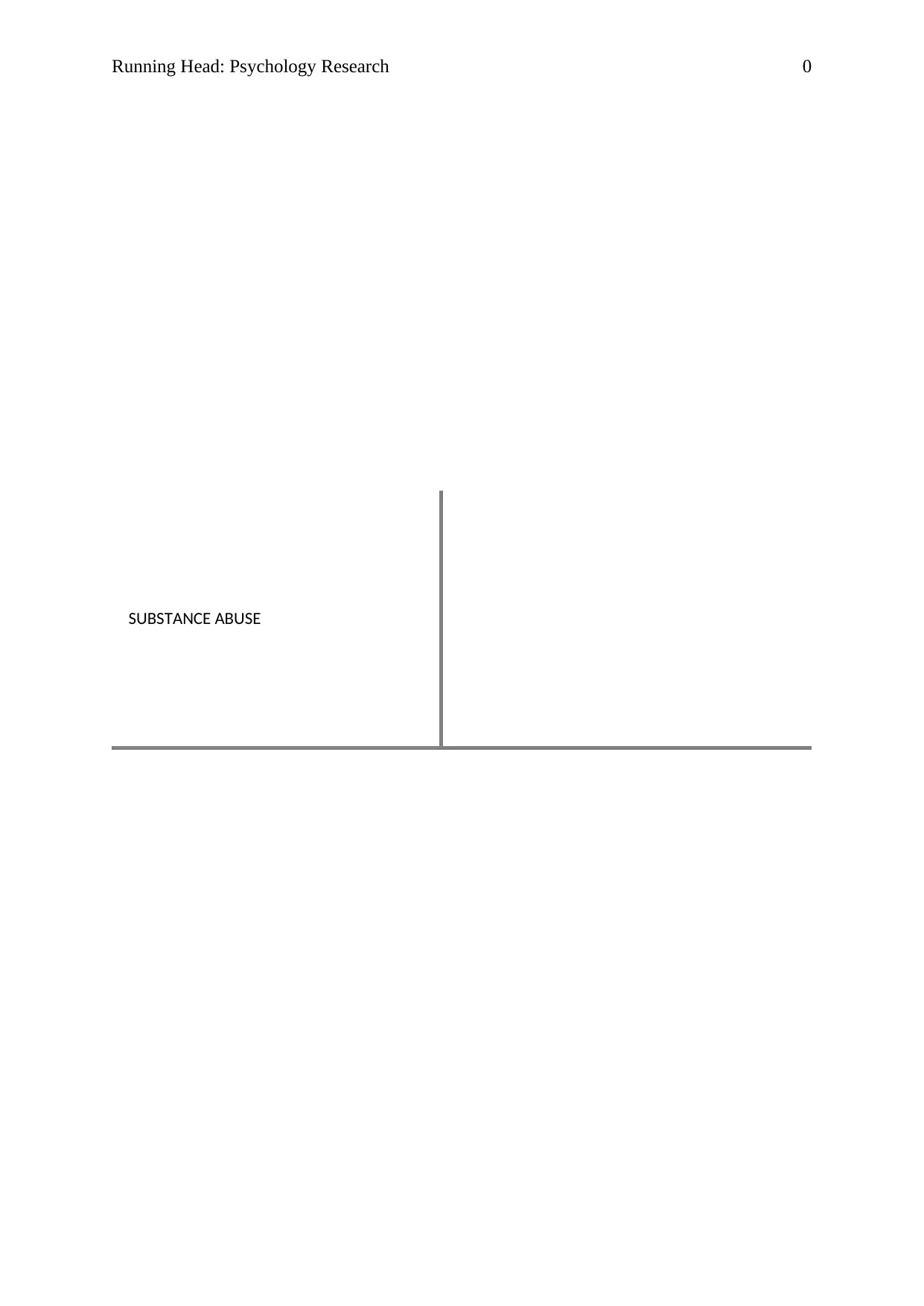
Running Head: Psychology Research 0
SUBSTANCE ABUSE
SUBSTANCE ABUSE
Paraphrase This Document
Need a fresh take? Get an instant paraphrase of this document with our AI Paraphraser
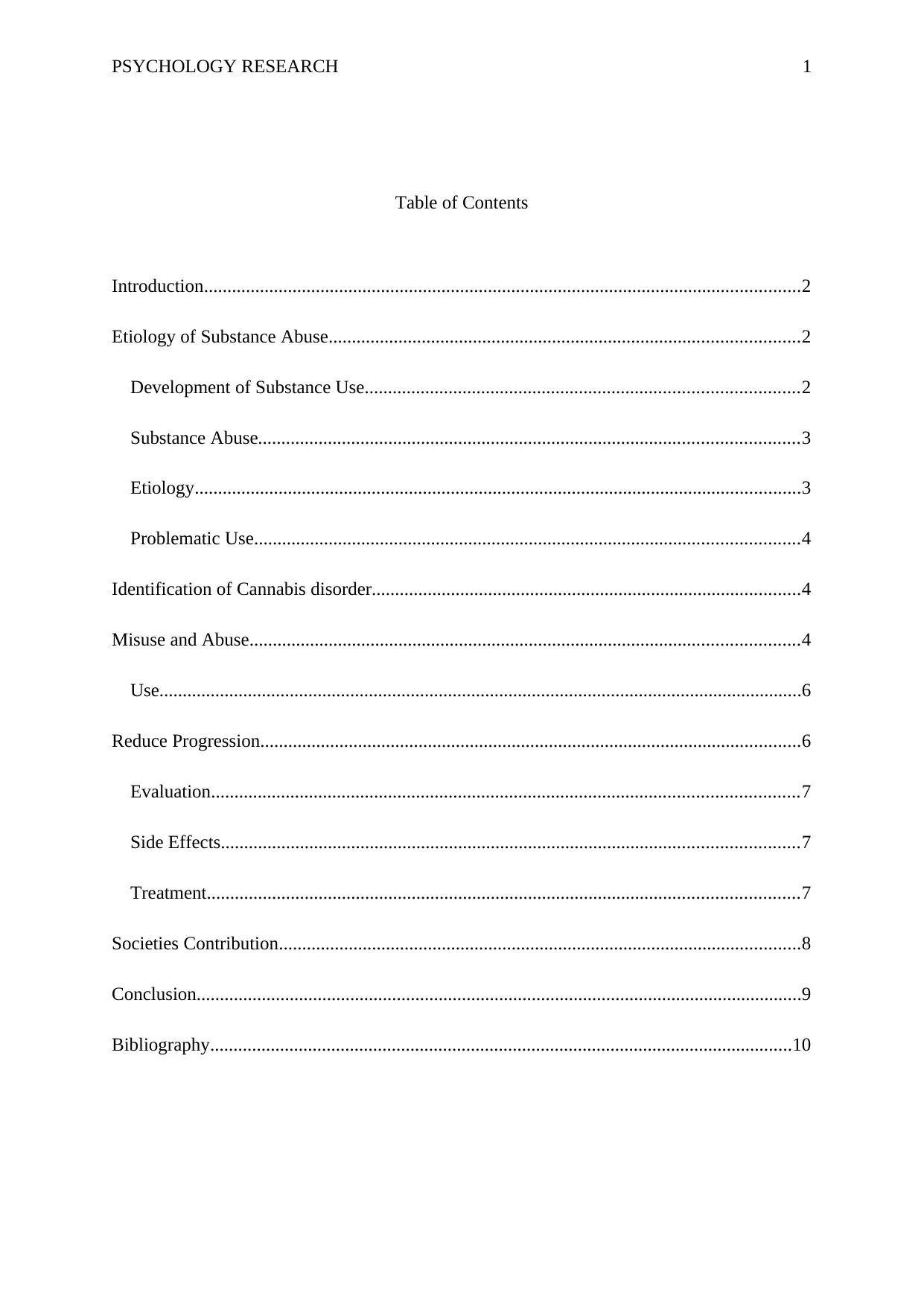
PSYCHOLOGY RESEARCH 1
Table of Contents
Introduction................................................................................................................................2
Etiology of Substance Abuse.....................................................................................................2
Development of Substance Use.............................................................................................2
Substance Abuse....................................................................................................................3
Etiology..................................................................................................................................3
Problematic Use.....................................................................................................................4
Identification of Cannabis disorder............................................................................................4
Misuse and Abuse......................................................................................................................4
Use..........................................................................................................................................6
Reduce Progression....................................................................................................................6
Evaluation..............................................................................................................................7
Side Effects............................................................................................................................7
Treatment...............................................................................................................................7
Societies Contribution................................................................................................................8
Conclusion..................................................................................................................................9
Bibliography.............................................................................................................................10
Table of Contents
Introduction................................................................................................................................2
Etiology of Substance Abuse.....................................................................................................2
Development of Substance Use.............................................................................................2
Substance Abuse....................................................................................................................3
Etiology..................................................................................................................................3
Problematic Use.....................................................................................................................4
Identification of Cannabis disorder............................................................................................4
Misuse and Abuse......................................................................................................................4
Use..........................................................................................................................................6
Reduce Progression....................................................................................................................6
Evaluation..............................................................................................................................7
Side Effects............................................................................................................................7
Treatment...............................................................................................................................7
Societies Contribution................................................................................................................8
Conclusion..................................................................................................................................9
Bibliography.............................................................................................................................10
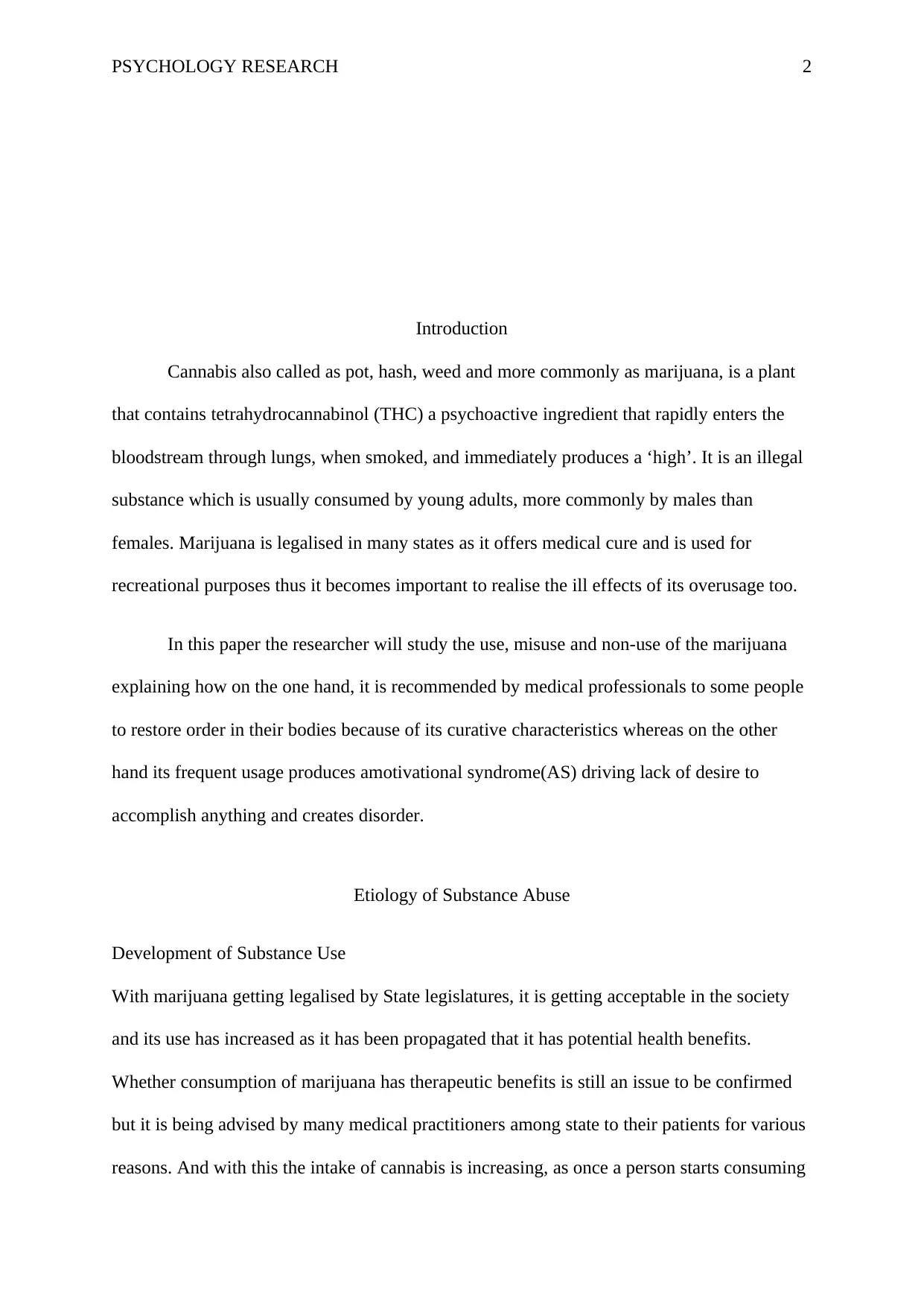
PSYCHOLOGY RESEARCH 2
Introduction
Cannabis also called as pot, hash, weed and more commonly as marijuana, is a plant
that contains tetrahydrocannabinol (THC) a psychoactive ingredient that rapidly enters the
bloodstream through lungs, when smoked, and immediately produces a ‘high’. It is an illegal
substance which is usually consumed by young adults, more commonly by males than
females. Marijuana is legalised in many states as it offers medical cure and is used for
recreational purposes thus it becomes important to realise the ill effects of its overusage too.
In this paper the researcher will study the use, misuse and non-use of the marijuana
explaining how on the one hand, it is recommended by medical professionals to some people
to restore order in their bodies because of its curative characteristics whereas on the other
hand its frequent usage produces amotivational syndrome(AS) driving lack of desire to
accomplish anything and creates disorder.
Etiology of Substance Abuse
Development of Substance Use
With marijuana getting legalised by State legislatures, it is getting acceptable in the society
and its use has increased as it has been propagated that it has potential health benefits.
Whether consumption of marijuana has therapeutic benefits is still an issue to be confirmed
but it is being advised by many medical practitioners among state to their patients for various
reasons. And with this the intake of cannabis is increasing, as once a person starts consuming
Introduction
Cannabis also called as pot, hash, weed and more commonly as marijuana, is a plant
that contains tetrahydrocannabinol (THC) a psychoactive ingredient that rapidly enters the
bloodstream through lungs, when smoked, and immediately produces a ‘high’. It is an illegal
substance which is usually consumed by young adults, more commonly by males than
females. Marijuana is legalised in many states as it offers medical cure and is used for
recreational purposes thus it becomes important to realise the ill effects of its overusage too.
In this paper the researcher will study the use, misuse and non-use of the marijuana
explaining how on the one hand, it is recommended by medical professionals to some people
to restore order in their bodies because of its curative characteristics whereas on the other
hand its frequent usage produces amotivational syndrome(AS) driving lack of desire to
accomplish anything and creates disorder.
Etiology of Substance Abuse
Development of Substance Use
With marijuana getting legalised by State legislatures, it is getting acceptable in the society
and its use has increased as it has been propagated that it has potential health benefits.
Whether consumption of marijuana has therapeutic benefits is still an issue to be confirmed
but it is being advised by many medical practitioners among state to their patients for various
reasons. And with this the intake of cannabis is increasing, as once a person starts consuming
⊘ This is a preview!⊘
Do you want full access?
Subscribe today to unlock all pages.

Trusted by 1+ million students worldwide
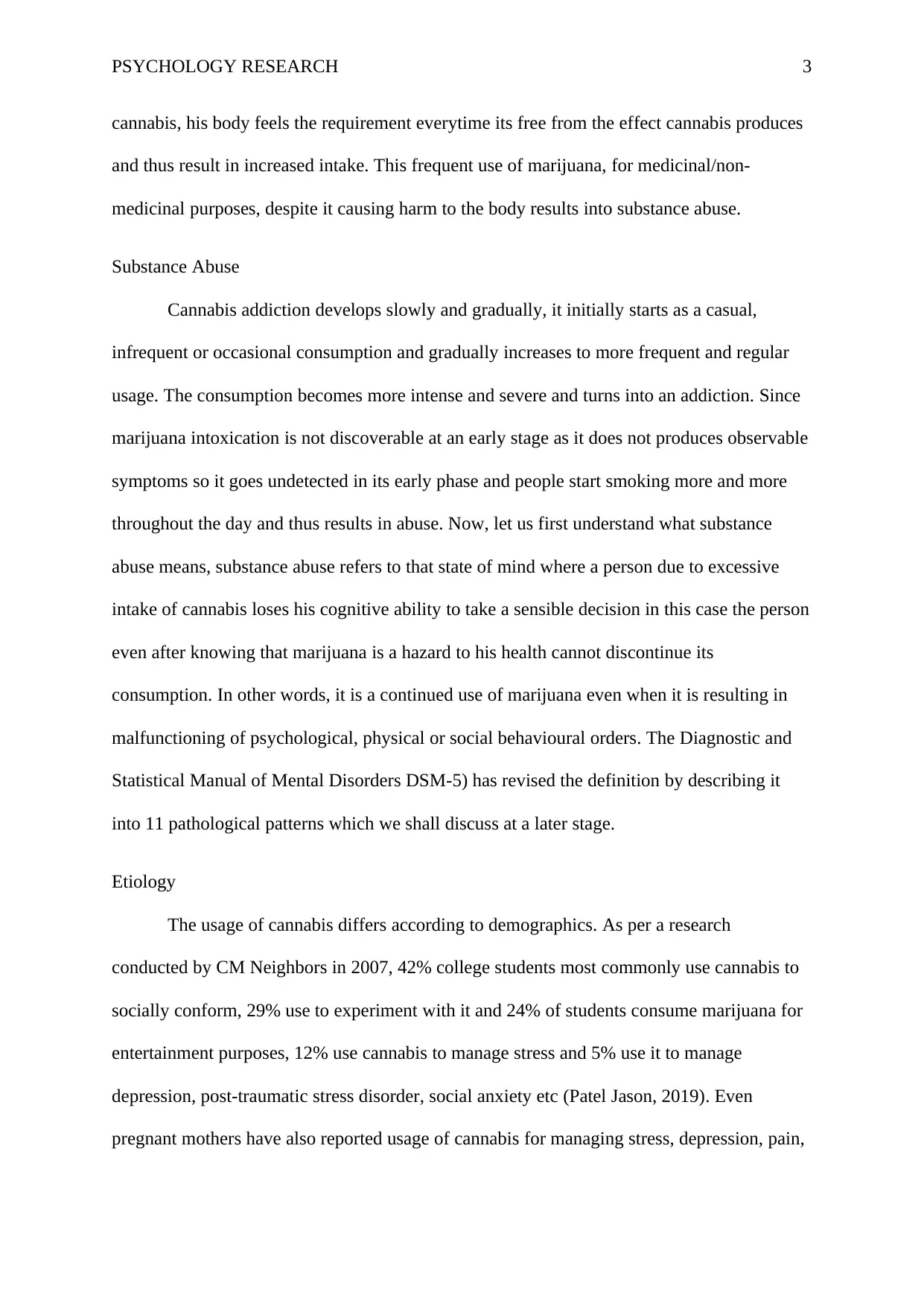
PSYCHOLOGY RESEARCH 3
cannabis, his body feels the requirement everytime its free from the effect cannabis produces
and thus result in increased intake. This frequent use of marijuana, for medicinal/non-
medicinal purposes, despite it causing harm to the body results into substance abuse.
Substance Abuse
Cannabis addiction develops slowly and gradually, it initially starts as a casual,
infrequent or occasional consumption and gradually increases to more frequent and regular
usage. The consumption becomes more intense and severe and turns into an addiction. Since
marijuana intoxication is not discoverable at an early stage as it does not produces observable
symptoms so it goes undetected in its early phase and people start smoking more and more
throughout the day and thus results in abuse. Now, let us first understand what substance
abuse means, substance abuse refers to that state of mind where a person due to excessive
intake of cannabis loses his cognitive ability to take a sensible decision in this case the person
even after knowing that marijuana is a hazard to his health cannot discontinue its
consumption. In other words, it is a continued use of marijuana even when it is resulting in
malfunctioning of psychological, physical or social behavioural orders. The Diagnostic and
Statistical Manual of Mental Disorders DSM-5) has revised the definition by describing it
into 11 pathological patterns which we shall discuss at a later stage.
Etiology
The usage of cannabis differs according to demographics. As per a research
conducted by CM Neighbors in 2007, 42% college students most commonly use cannabis to
socially conform, 29% use to experiment with it and 24% of students consume marijuana for
entertainment purposes, 12% use cannabis to manage stress and 5% use it to manage
depression, post-traumatic stress disorder, social anxiety etc (Patel Jason, 2019). Even
pregnant mothers have also reported usage of cannabis for managing stress, depression, pain,
cannabis, his body feels the requirement everytime its free from the effect cannabis produces
and thus result in increased intake. This frequent use of marijuana, for medicinal/non-
medicinal purposes, despite it causing harm to the body results into substance abuse.
Substance Abuse
Cannabis addiction develops slowly and gradually, it initially starts as a casual,
infrequent or occasional consumption and gradually increases to more frequent and regular
usage. The consumption becomes more intense and severe and turns into an addiction. Since
marijuana intoxication is not discoverable at an early stage as it does not produces observable
symptoms so it goes undetected in its early phase and people start smoking more and more
throughout the day and thus results in abuse. Now, let us first understand what substance
abuse means, substance abuse refers to that state of mind where a person due to excessive
intake of cannabis loses his cognitive ability to take a sensible decision in this case the person
even after knowing that marijuana is a hazard to his health cannot discontinue its
consumption. In other words, it is a continued use of marijuana even when it is resulting in
malfunctioning of psychological, physical or social behavioural orders. The Diagnostic and
Statistical Manual of Mental Disorders DSM-5) has revised the definition by describing it
into 11 pathological patterns which we shall discuss at a later stage.
Etiology
The usage of cannabis differs according to demographics. As per a research
conducted by CM Neighbors in 2007, 42% college students most commonly use cannabis to
socially conform, 29% use to experiment with it and 24% of students consume marijuana for
entertainment purposes, 12% use cannabis to manage stress and 5% use it to manage
depression, post-traumatic stress disorder, social anxiety etc (Patel Jason, 2019). Even
pregnant mothers have also reported usage of cannabis for managing stress, depression, pain,
Paraphrase This Document
Need a fresh take? Get an instant paraphrase of this document with our AI Paraphraser
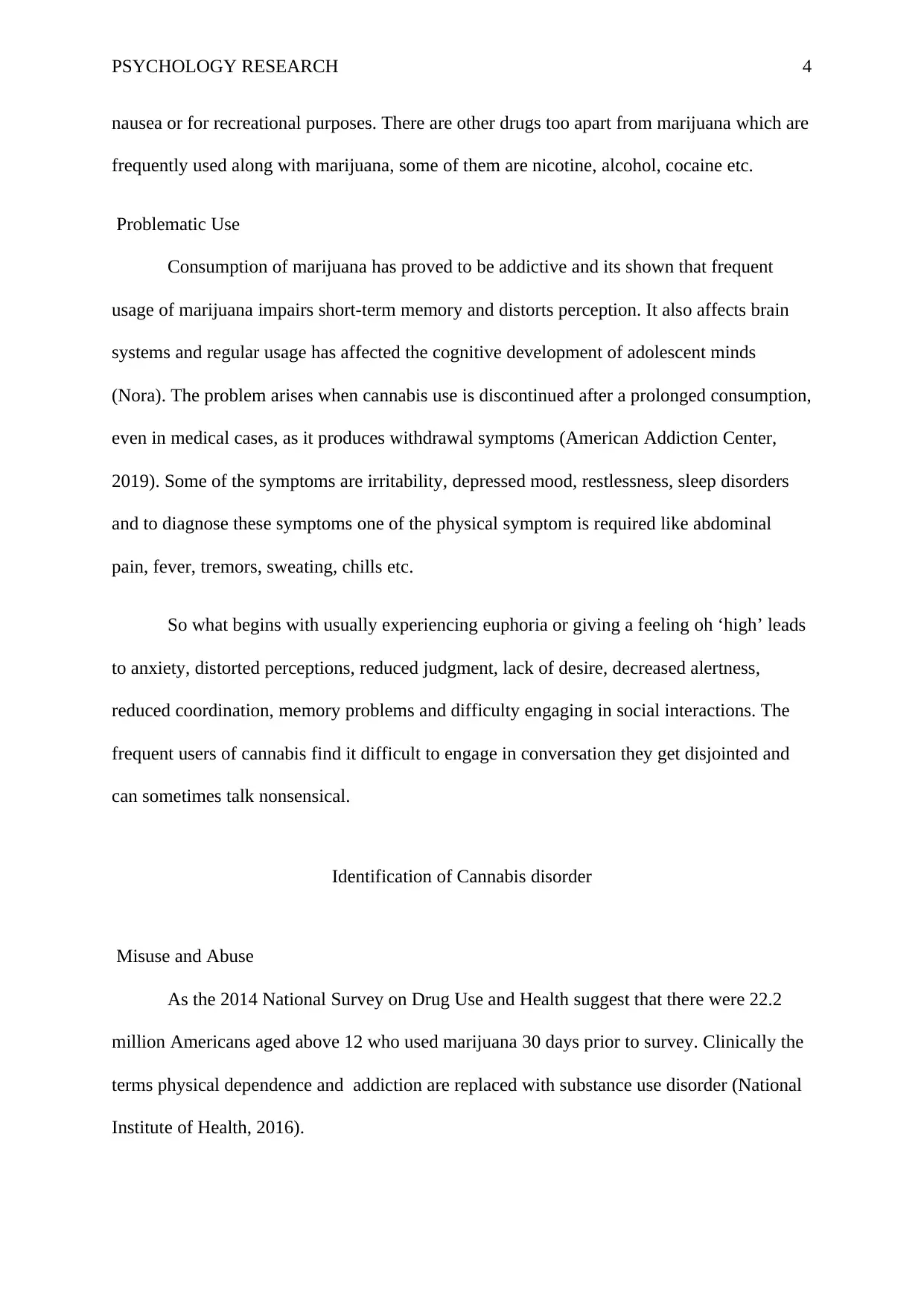
PSYCHOLOGY RESEARCH 4
nausea or for recreational purposes. There are other drugs too apart from marijuana which are
frequently used along with marijuana, some of them are nicotine, alcohol, cocaine etc.
Problematic Use
Consumption of marijuana has proved to be addictive and its shown that frequent
usage of marijuana impairs short-term memory and distorts perception. It also affects brain
systems and regular usage has affected the cognitive development of adolescent minds
(Nora). The problem arises when cannabis use is discontinued after a prolonged consumption,
even in medical cases, as it produces withdrawal symptoms (American Addiction Center,
2019). Some of the symptoms are irritability, depressed mood, restlessness, sleep disorders
and to diagnose these symptoms one of the physical symptom is required like abdominal
pain, fever, tremors, sweating, chills etc.
So what begins with usually experiencing euphoria or giving a feeling oh ‘high’ leads
to anxiety, distorted perceptions, reduced judgment, lack of desire, decreased alertness,
reduced coordination, memory problems and difficulty engaging in social interactions. The
frequent users of cannabis find it difficult to engage in conversation they get disjointed and
can sometimes talk nonsensical.
Identification of Cannabis disorder
Misuse and Abuse
As the 2014 National Survey on Drug Use and Health suggest that there were 22.2
million Americans aged above 12 who used marijuana 30 days prior to survey. Clinically the
terms physical dependence and addiction are replaced with substance use disorder (National
Institute of Health, 2016).
nausea or for recreational purposes. There are other drugs too apart from marijuana which are
frequently used along with marijuana, some of them are nicotine, alcohol, cocaine etc.
Problematic Use
Consumption of marijuana has proved to be addictive and its shown that frequent
usage of marijuana impairs short-term memory and distorts perception. It also affects brain
systems and regular usage has affected the cognitive development of adolescent minds
(Nora). The problem arises when cannabis use is discontinued after a prolonged consumption,
even in medical cases, as it produces withdrawal symptoms (American Addiction Center,
2019). Some of the symptoms are irritability, depressed mood, restlessness, sleep disorders
and to diagnose these symptoms one of the physical symptom is required like abdominal
pain, fever, tremors, sweating, chills etc.
So what begins with usually experiencing euphoria or giving a feeling oh ‘high’ leads
to anxiety, distorted perceptions, reduced judgment, lack of desire, decreased alertness,
reduced coordination, memory problems and difficulty engaging in social interactions. The
frequent users of cannabis find it difficult to engage in conversation they get disjointed and
can sometimes talk nonsensical.
Identification of Cannabis disorder
Misuse and Abuse
As the 2014 National Survey on Drug Use and Health suggest that there were 22.2
million Americans aged above 12 who used marijuana 30 days prior to survey. Clinically the
terms physical dependence and addiction are replaced with substance use disorder (National
Institute of Health, 2016).
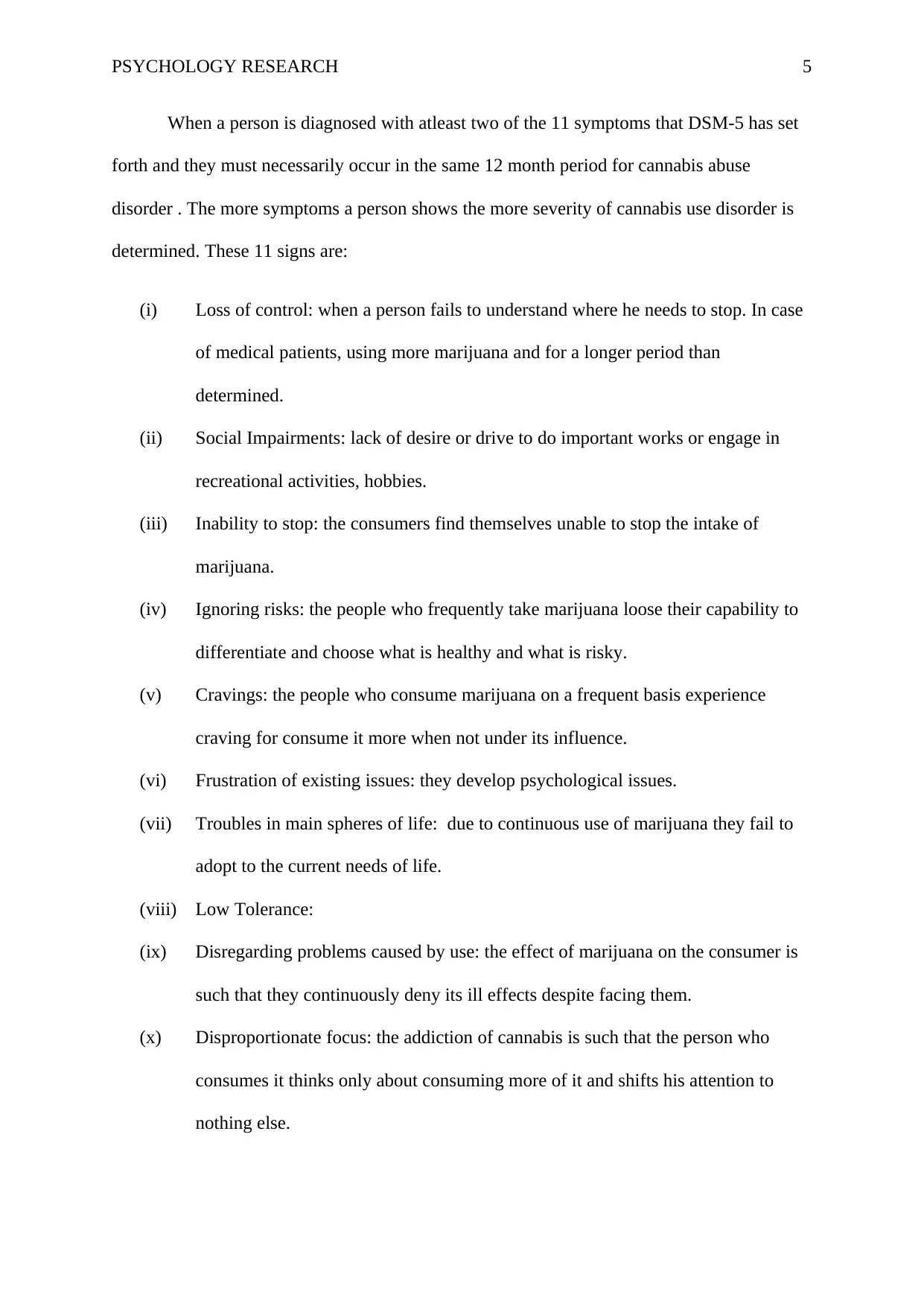
PSYCHOLOGY RESEARCH 5
When a person is diagnosed with atleast two of the 11 symptoms that DSM-5 has set
forth and they must necessarily occur in the same 12 month period for cannabis abuse
disorder . The more symptoms a person shows the more severity of cannabis use disorder is
determined. These 11 signs are:
(i) Loss of control: when a person fails to understand where he needs to stop. In case
of medical patients, using more marijuana and for a longer period than
determined.
(ii) Social Impairments: lack of desire or drive to do important works or engage in
recreational activities, hobbies.
(iii) Inability to stop: the consumers find themselves unable to stop the intake of
marijuana.
(iv) Ignoring risks: the people who frequently take marijuana loose their capability to
differentiate and choose what is healthy and what is risky.
(v) Cravings: the people who consume marijuana on a frequent basis experience
craving for consume it more when not under its influence.
(vi) Frustration of existing issues: they develop psychological issues.
(vii) Troubles in main spheres of life: due to continuous use of marijuana they fail to
adopt to the current needs of life.
(viii) Low Tolerance:
(ix) Disregarding problems caused by use: the effect of marijuana on the consumer is
such that they continuously deny its ill effects despite facing them.
(x) Disproportionate focus: the addiction of cannabis is such that the person who
consumes it thinks only about consuming more of it and shifts his attention to
nothing else.
When a person is diagnosed with atleast two of the 11 symptoms that DSM-5 has set
forth and they must necessarily occur in the same 12 month period for cannabis abuse
disorder . The more symptoms a person shows the more severity of cannabis use disorder is
determined. These 11 signs are:
(i) Loss of control: when a person fails to understand where he needs to stop. In case
of medical patients, using more marijuana and for a longer period than
determined.
(ii) Social Impairments: lack of desire or drive to do important works or engage in
recreational activities, hobbies.
(iii) Inability to stop: the consumers find themselves unable to stop the intake of
marijuana.
(iv) Ignoring risks: the people who frequently take marijuana loose their capability to
differentiate and choose what is healthy and what is risky.
(v) Cravings: the people who consume marijuana on a frequent basis experience
craving for consume it more when not under its influence.
(vi) Frustration of existing issues: they develop psychological issues.
(vii) Troubles in main spheres of life: due to continuous use of marijuana they fail to
adopt to the current needs of life.
(viii) Low Tolerance:
(ix) Disregarding problems caused by use: the effect of marijuana on the consumer is
such that they continuously deny its ill effects despite facing them.
(x) Disproportionate focus: the addiction of cannabis is such that the person who
consumes it thinks only about consuming more of it and shifts his attention to
nothing else.
⊘ This is a preview!⊘
Do you want full access?
Subscribe today to unlock all pages.

Trusted by 1+ million students worldwide
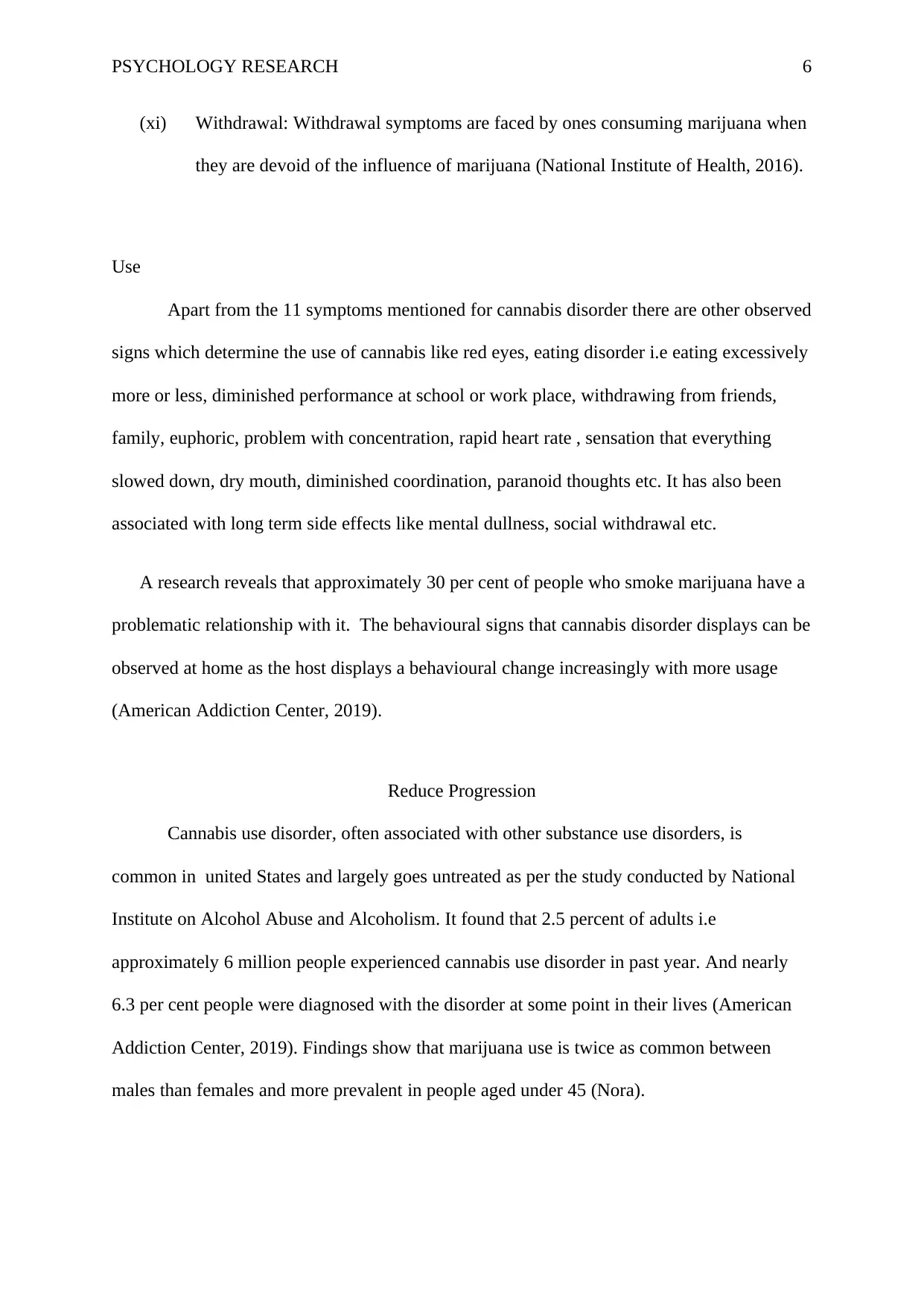
PSYCHOLOGY RESEARCH 6
(xi) Withdrawal: Withdrawal symptoms are faced by ones consuming marijuana when
they are devoid of the influence of marijuana (National Institute of Health, 2016).
Use
Apart from the 11 symptoms mentioned for cannabis disorder there are other observed
signs which determine the use of cannabis like red eyes, eating disorder i.e eating excessively
more or less, diminished performance at school or work place, withdrawing from friends,
family, euphoric, problem with concentration, rapid heart rate , sensation that everything
slowed down, dry mouth, diminished coordination, paranoid thoughts etc. It has also been
associated with long term side effects like mental dullness, social withdrawal etc.
A research reveals that approximately 30 per cent of people who smoke marijuana have a
problematic relationship with it. The behavioural signs that cannabis disorder displays can be
observed at home as the host displays a behavioural change increasingly with more usage
(American Addiction Center, 2019).
Reduce Progression
Cannabis use disorder, often associated with other substance use disorders, is
common in united States and largely goes untreated as per the study conducted by National
Institute on Alcohol Abuse and Alcoholism. It found that 2.5 percent of adults i.e
approximately 6 million people experienced cannabis use disorder in past year. And nearly
6.3 per cent people were diagnosed with the disorder at some point in their lives (American
Addiction Center, 2019). Findings show that marijuana use is twice as common between
males than females and more prevalent in people aged under 45 (Nora).
(xi) Withdrawal: Withdrawal symptoms are faced by ones consuming marijuana when
they are devoid of the influence of marijuana (National Institute of Health, 2016).
Use
Apart from the 11 symptoms mentioned for cannabis disorder there are other observed
signs which determine the use of cannabis like red eyes, eating disorder i.e eating excessively
more or less, diminished performance at school or work place, withdrawing from friends,
family, euphoric, problem with concentration, rapid heart rate , sensation that everything
slowed down, dry mouth, diminished coordination, paranoid thoughts etc. It has also been
associated with long term side effects like mental dullness, social withdrawal etc.
A research reveals that approximately 30 per cent of people who smoke marijuana have a
problematic relationship with it. The behavioural signs that cannabis disorder displays can be
observed at home as the host displays a behavioural change increasingly with more usage
(American Addiction Center, 2019).
Reduce Progression
Cannabis use disorder, often associated with other substance use disorders, is
common in united States and largely goes untreated as per the study conducted by National
Institute on Alcohol Abuse and Alcoholism. It found that 2.5 percent of adults i.e
approximately 6 million people experienced cannabis use disorder in past year. And nearly
6.3 per cent people were diagnosed with the disorder at some point in their lives (American
Addiction Center, 2019). Findings show that marijuana use is twice as common between
males than females and more prevalent in people aged under 45 (Nora).
Paraphrase This Document
Need a fresh take? Get an instant paraphrase of this document with our AI Paraphraser
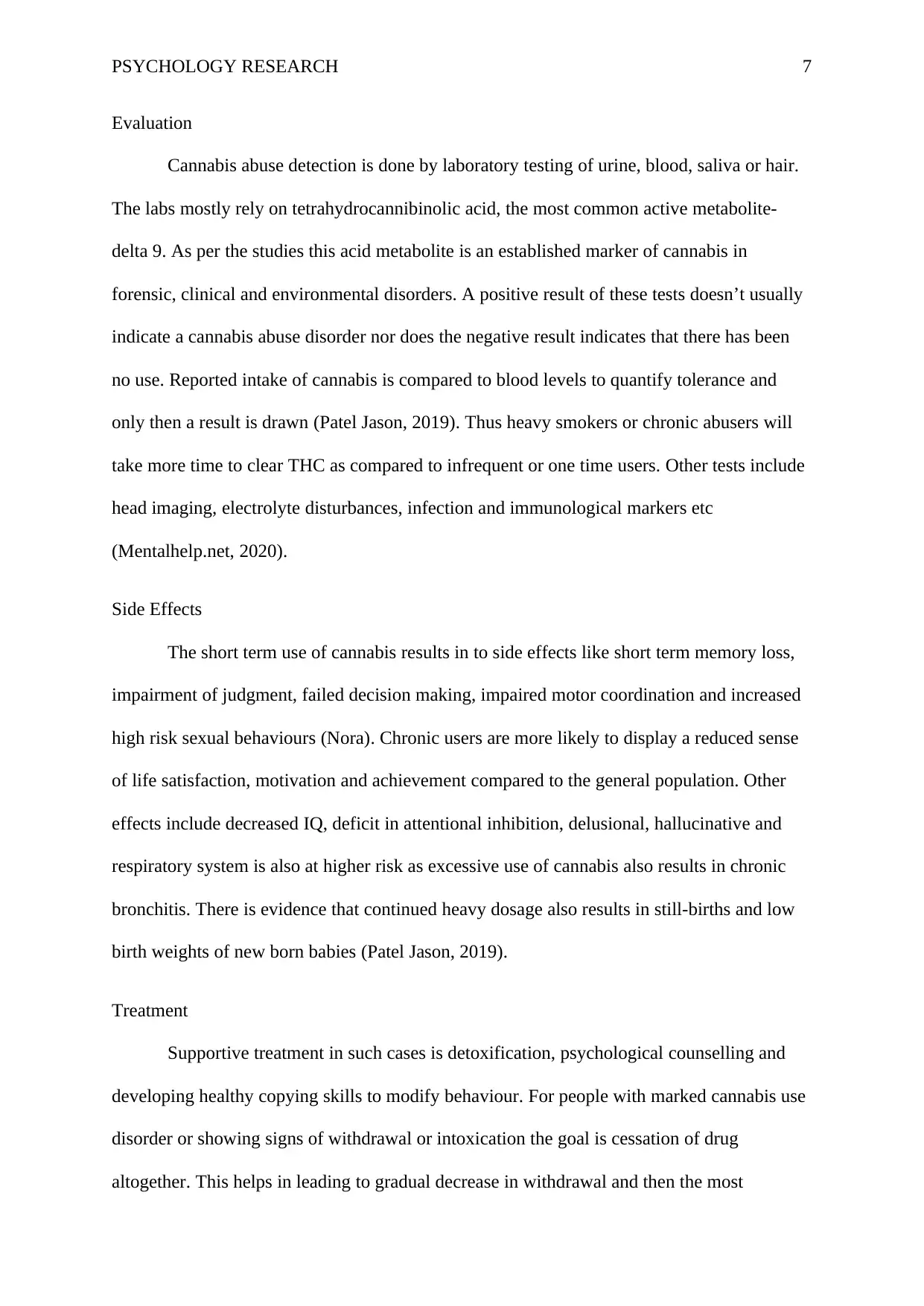
PSYCHOLOGY RESEARCH 7
Evaluation
Cannabis abuse detection is done by laboratory testing of urine, blood, saliva or hair.
The labs mostly rely on tetrahydrocannibinolic acid, the most common active metabolite-
delta 9. As per the studies this acid metabolite is an established marker of cannabis in
forensic, clinical and environmental disorders. A positive result of these tests doesn’t usually
indicate a cannabis abuse disorder nor does the negative result indicates that there has been
no use. Reported intake of cannabis is compared to blood levels to quantify tolerance and
only then a result is drawn (Patel Jason, 2019). Thus heavy smokers or chronic abusers will
take more time to clear THC as compared to infrequent or one time users. Other tests include
head imaging, electrolyte disturbances, infection and immunological markers etc
(Mentalhelp.net, 2020).
Side Effects
The short term use of cannabis results in to side effects like short term memory loss,
impairment of judgment, failed decision making, impaired motor coordination and increased
high risk sexual behaviours (Nora). Chronic users are more likely to display a reduced sense
of life satisfaction, motivation and achievement compared to the general population. Other
effects include decreased IQ, deficit in attentional inhibition, delusional, hallucinative and
respiratory system is also at higher risk as excessive use of cannabis also results in chronic
bronchitis. There is evidence that continued heavy dosage also results in still-births and low
birth weights of new born babies (Patel Jason, 2019).
Treatment
Supportive treatment in such cases is detoxification, psychological counselling and
developing healthy copying skills to modify behaviour. For people with marked cannabis use
disorder or showing signs of withdrawal or intoxication the goal is cessation of drug
altogether. This helps in leading to gradual decrease in withdrawal and then the most
Evaluation
Cannabis abuse detection is done by laboratory testing of urine, blood, saliva or hair.
The labs mostly rely on tetrahydrocannibinolic acid, the most common active metabolite-
delta 9. As per the studies this acid metabolite is an established marker of cannabis in
forensic, clinical and environmental disorders. A positive result of these tests doesn’t usually
indicate a cannabis abuse disorder nor does the negative result indicates that there has been
no use. Reported intake of cannabis is compared to blood levels to quantify tolerance and
only then a result is drawn (Patel Jason, 2019). Thus heavy smokers or chronic abusers will
take more time to clear THC as compared to infrequent or one time users. Other tests include
head imaging, electrolyte disturbances, infection and immunological markers etc
(Mentalhelp.net, 2020).
Side Effects
The short term use of cannabis results in to side effects like short term memory loss,
impairment of judgment, failed decision making, impaired motor coordination and increased
high risk sexual behaviours (Nora). Chronic users are more likely to display a reduced sense
of life satisfaction, motivation and achievement compared to the general population. Other
effects include decreased IQ, deficit in attentional inhibition, delusional, hallucinative and
respiratory system is also at higher risk as excessive use of cannabis also results in chronic
bronchitis. There is evidence that continued heavy dosage also results in still-births and low
birth weights of new born babies (Patel Jason, 2019).
Treatment
Supportive treatment in such cases is detoxification, psychological counselling and
developing healthy copying skills to modify behaviour. For people with marked cannabis use
disorder or showing signs of withdrawal or intoxication the goal is cessation of drug
altogether. This helps in leading to gradual decrease in withdrawal and then the most
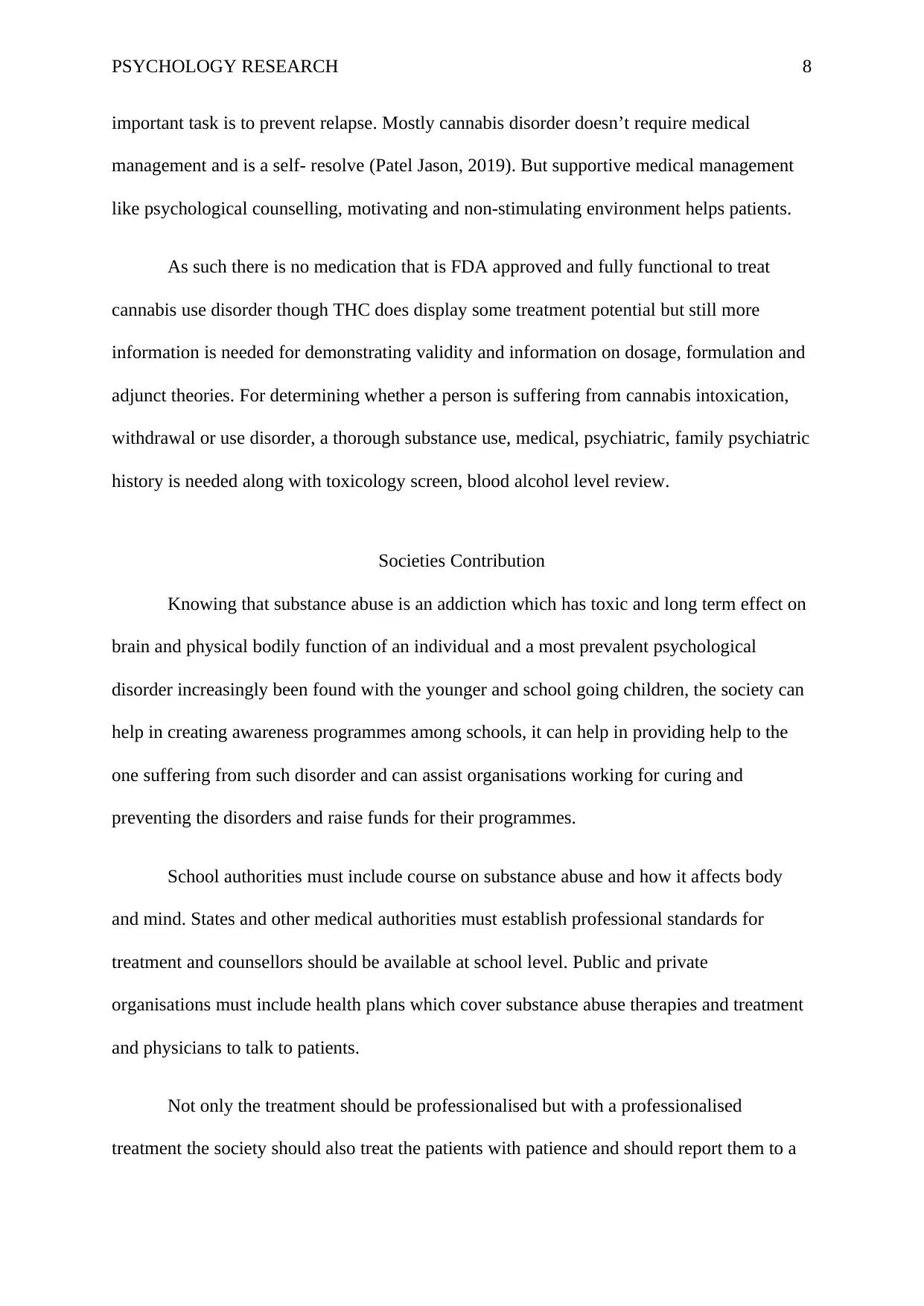
PSYCHOLOGY RESEARCH 8
important task is to prevent relapse. Mostly cannabis disorder doesn’t require medical
management and is a self- resolve (Patel Jason, 2019). But supportive medical management
like psychological counselling, motivating and non-stimulating environment helps patients.
As such there is no medication that is FDA approved and fully functional to treat
cannabis use disorder though THC does display some treatment potential but still more
information is needed for demonstrating validity and information on dosage, formulation and
adjunct theories. For determining whether a person is suffering from cannabis intoxication,
withdrawal or use disorder, a thorough substance use, medical, psychiatric, family psychiatric
history is needed along with toxicology screen, blood alcohol level review.
Societies Contribution
Knowing that substance abuse is an addiction which has toxic and long term effect on
brain and physical bodily function of an individual and a most prevalent psychological
disorder increasingly been found with the younger and school going children, the society can
help in creating awareness programmes among schools, it can help in providing help to the
one suffering from such disorder and can assist organisations working for curing and
preventing the disorders and raise funds for their programmes.
School authorities must include course on substance abuse and how it affects body
and mind. States and other medical authorities must establish professional standards for
treatment and counsellors should be available at school level. Public and private
organisations must include health plans which cover substance abuse therapies and treatment
and physicians to talk to patients.
Not only the treatment should be professionalised but with a professionalised
treatment the society should also treat the patients with patience and should report them to a
important task is to prevent relapse. Mostly cannabis disorder doesn’t require medical
management and is a self- resolve (Patel Jason, 2019). But supportive medical management
like psychological counselling, motivating and non-stimulating environment helps patients.
As such there is no medication that is FDA approved and fully functional to treat
cannabis use disorder though THC does display some treatment potential but still more
information is needed for demonstrating validity and information on dosage, formulation and
adjunct theories. For determining whether a person is suffering from cannabis intoxication,
withdrawal or use disorder, a thorough substance use, medical, psychiatric, family psychiatric
history is needed along with toxicology screen, blood alcohol level review.
Societies Contribution
Knowing that substance abuse is an addiction which has toxic and long term effect on
brain and physical bodily function of an individual and a most prevalent psychological
disorder increasingly been found with the younger and school going children, the society can
help in creating awareness programmes among schools, it can help in providing help to the
one suffering from such disorder and can assist organisations working for curing and
preventing the disorders and raise funds for their programmes.
School authorities must include course on substance abuse and how it affects body
and mind. States and other medical authorities must establish professional standards for
treatment and counsellors should be available at school level. Public and private
organisations must include health plans which cover substance abuse therapies and treatment
and physicians to talk to patients.
Not only the treatment should be professionalised but with a professionalised
treatment the society should also treat the patients with patience and should report them to a
⊘ This is a preview!⊘
Do you want full access?
Subscribe today to unlock all pages.

Trusted by 1+ million students worldwide
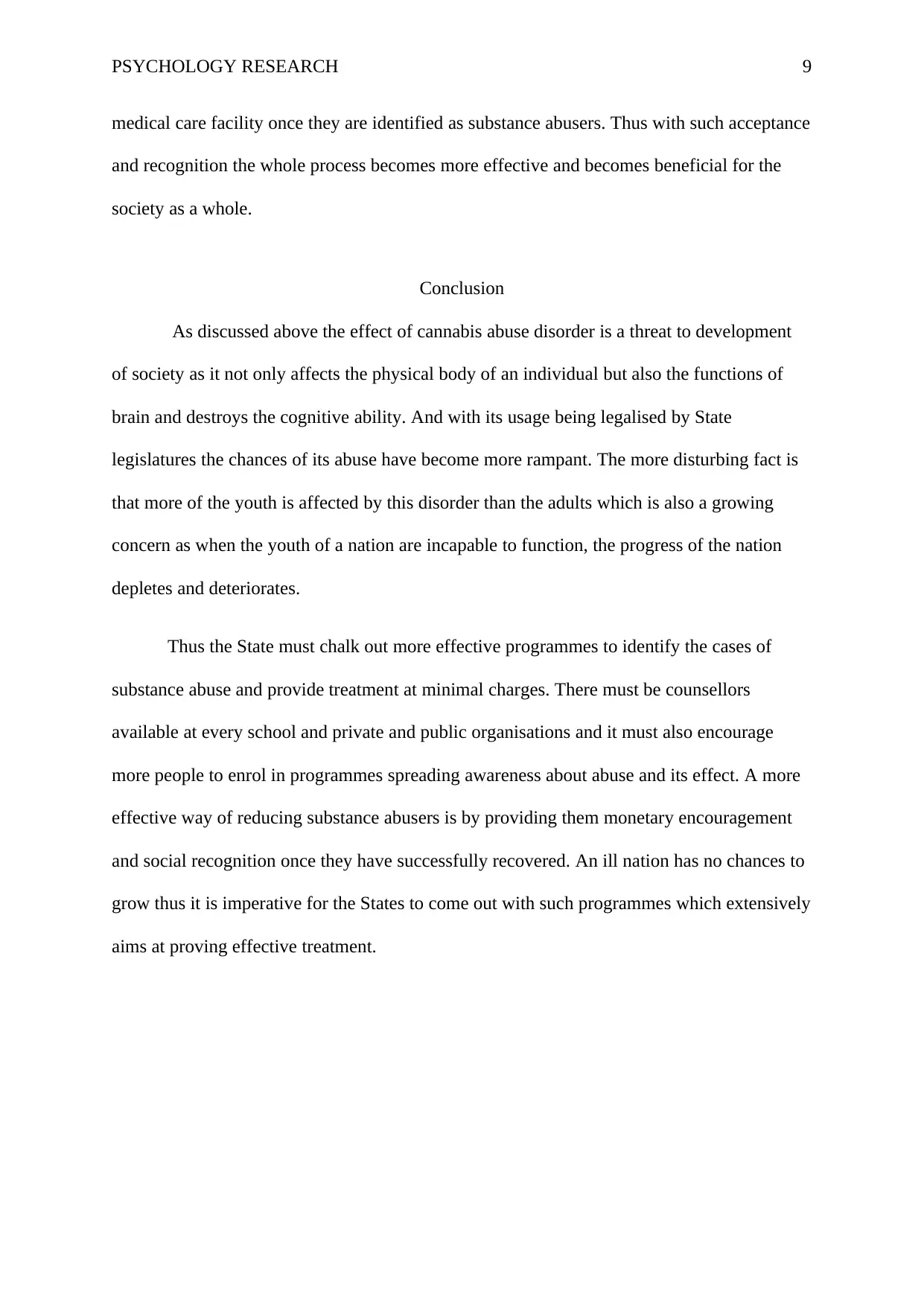
PSYCHOLOGY RESEARCH 9
medical care facility once they are identified as substance abusers. Thus with such acceptance
and recognition the whole process becomes more effective and becomes beneficial for the
society as a whole.
Conclusion
As discussed above the effect of cannabis abuse disorder is a threat to development
of society as it not only affects the physical body of an individual but also the functions of
brain and destroys the cognitive ability. And with its usage being legalised by State
legislatures the chances of its abuse have become more rampant. The more disturbing fact is
that more of the youth is affected by this disorder than the adults which is also a growing
concern as when the youth of a nation are incapable to function, the progress of the nation
depletes and deteriorates.
Thus the State must chalk out more effective programmes to identify the cases of
substance abuse and provide treatment at minimal charges. There must be counsellors
available at every school and private and public organisations and it must also encourage
more people to enrol in programmes spreading awareness about abuse and its effect. A more
effective way of reducing substance abusers is by providing them monetary encouragement
and social recognition once they have successfully recovered. An ill nation has no chances to
grow thus it is imperative for the States to come out with such programmes which extensively
aims at proving effective treatment.
medical care facility once they are identified as substance abusers. Thus with such acceptance
and recognition the whole process becomes more effective and becomes beneficial for the
society as a whole.
Conclusion
As discussed above the effect of cannabis abuse disorder is a threat to development
of society as it not only affects the physical body of an individual but also the functions of
brain and destroys the cognitive ability. And with its usage being legalised by State
legislatures the chances of its abuse have become more rampant. The more disturbing fact is
that more of the youth is affected by this disorder than the adults which is also a growing
concern as when the youth of a nation are incapable to function, the progress of the nation
depletes and deteriorates.
Thus the State must chalk out more effective programmes to identify the cases of
substance abuse and provide treatment at minimal charges. There must be counsellors
available at every school and private and public organisations and it must also encourage
more people to enrol in programmes spreading awareness about abuse and its effect. A more
effective way of reducing substance abusers is by providing them monetary encouragement
and social recognition once they have successfully recovered. An ill nation has no chances to
grow thus it is imperative for the States to come out with such programmes which extensively
aims at proving effective treatment.
Paraphrase This Document
Need a fresh take? Get an instant paraphrase of this document with our AI Paraphraser
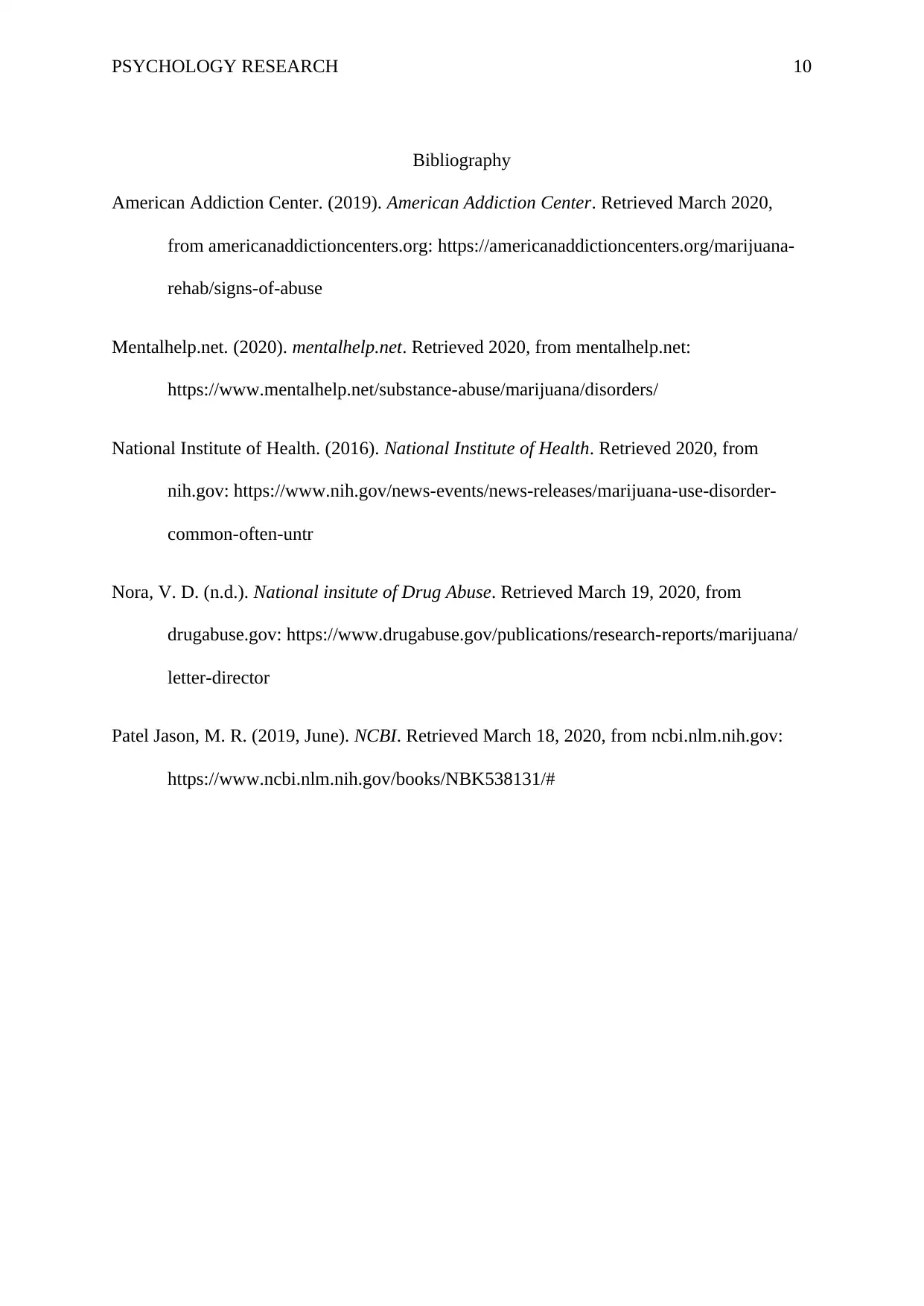
PSYCHOLOGY RESEARCH 10
Bibliography
American Addiction Center. (2019). American Addiction Center. Retrieved March 2020,
from americanaddictioncenters.org: https://americanaddictioncenters.org/marijuana-
rehab/signs-of-abuse
Mentalhelp.net. (2020). mentalhelp.net. Retrieved 2020, from mentalhelp.net:
https://www.mentalhelp.net/substance-abuse/marijuana/disorders/
National Institute of Health. (2016). National Institute of Health. Retrieved 2020, from
nih.gov: https://www.nih.gov/news-events/news-releases/marijuana-use-disorder-
common-often-untr
Nora, V. D. (n.d.). National insitute of Drug Abuse. Retrieved March 19, 2020, from
drugabuse.gov: https://www.drugabuse.gov/publications/research-reports/marijuana/
letter-director
Patel Jason, M. R. (2019, June). NCBI. Retrieved March 18, 2020, from ncbi.nlm.nih.gov:
https://www.ncbi.nlm.nih.gov/books/NBK538131/#
Bibliography
American Addiction Center. (2019). American Addiction Center. Retrieved March 2020,
from americanaddictioncenters.org: https://americanaddictioncenters.org/marijuana-
rehab/signs-of-abuse
Mentalhelp.net. (2020). mentalhelp.net. Retrieved 2020, from mentalhelp.net:
https://www.mentalhelp.net/substance-abuse/marijuana/disorders/
National Institute of Health. (2016). National Institute of Health. Retrieved 2020, from
nih.gov: https://www.nih.gov/news-events/news-releases/marijuana-use-disorder-
common-often-untr
Nora, V. D. (n.d.). National insitute of Drug Abuse. Retrieved March 19, 2020, from
drugabuse.gov: https://www.drugabuse.gov/publications/research-reports/marijuana/
letter-director
Patel Jason, M. R. (2019, June). NCBI. Retrieved March 18, 2020, from ncbi.nlm.nih.gov:
https://www.ncbi.nlm.nih.gov/books/NBK538131/#
1 out of 11
Related Documents
Your All-in-One AI-Powered Toolkit for Academic Success.
+13062052269
info@desklib.com
Available 24*7 on WhatsApp / Email
![[object Object]](/_next/static/media/star-bottom.7253800d.svg)
Unlock your academic potential
Copyright © 2020–2025 A2Z Services. All Rights Reserved. Developed and managed by ZUCOL.





